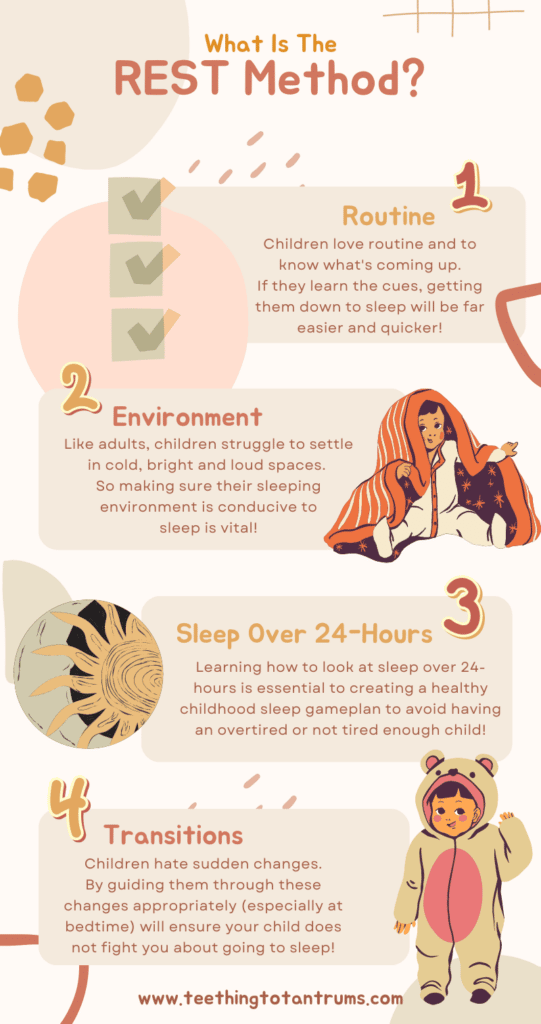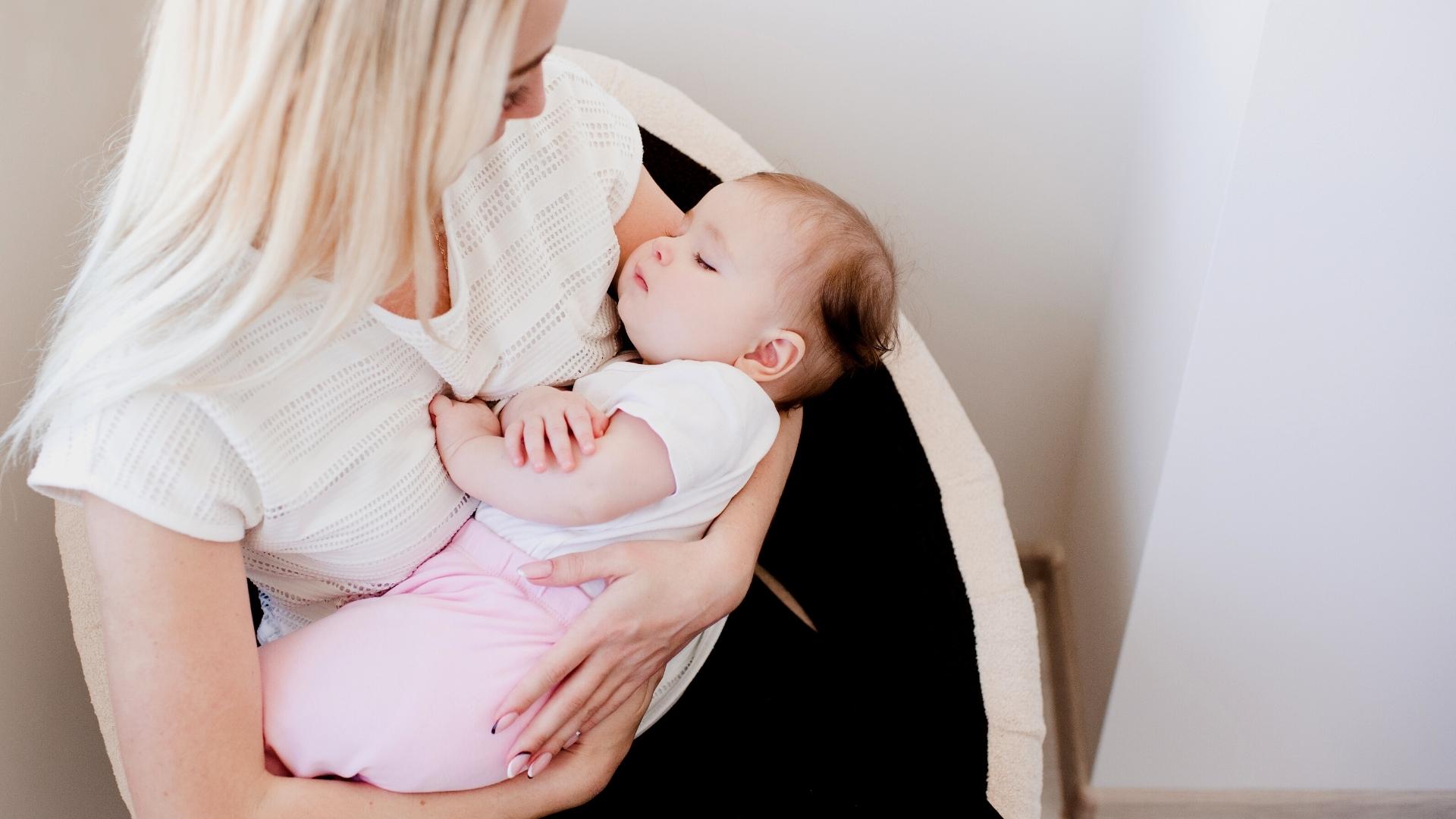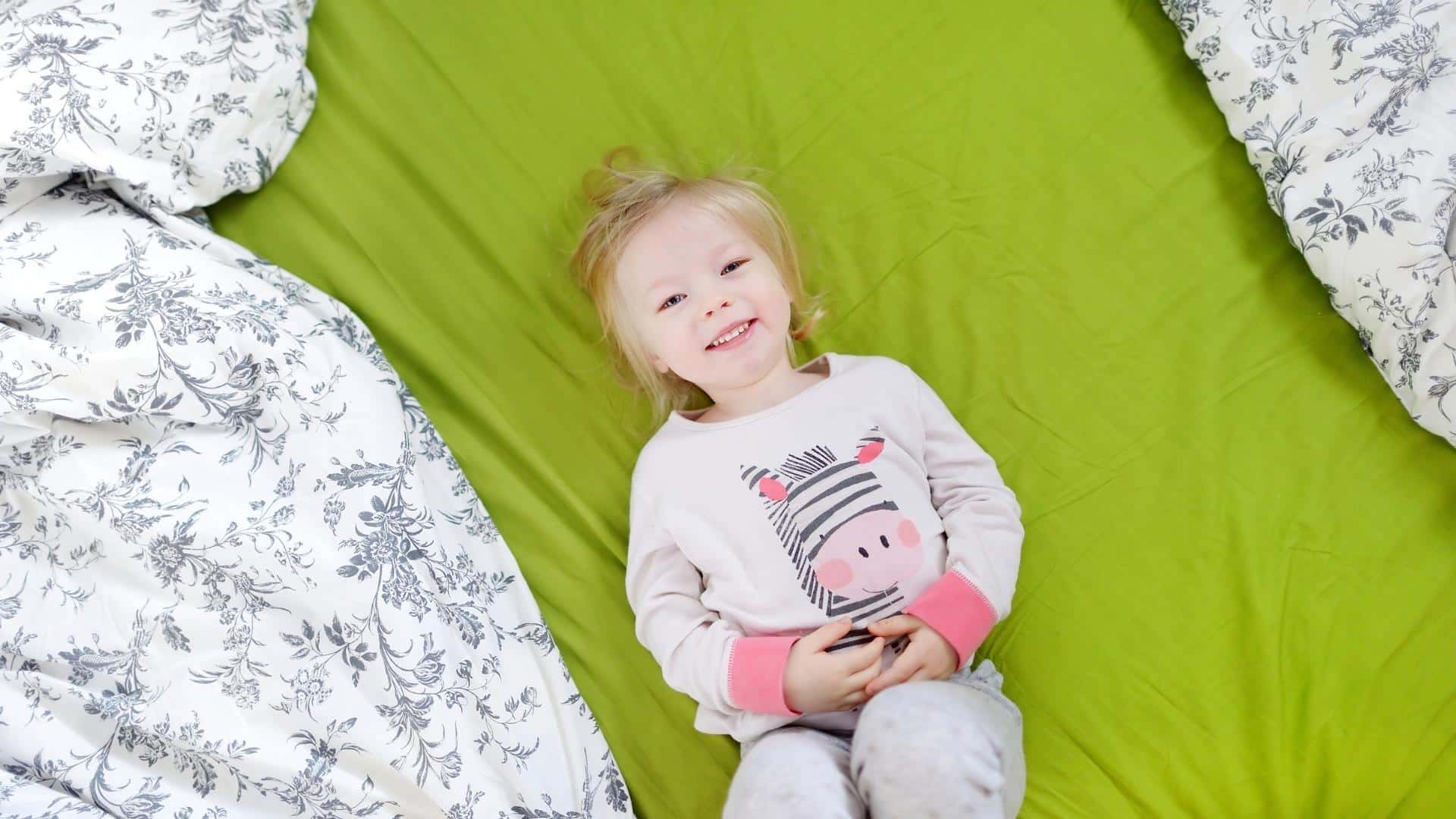Want to be able to finally get your children to sleep without fighting them at every turn? To enjoy the bedtime routine? To be able to look forward to a child-free evening? Let me introduce you to the REST method.
The REST Method
When talking to many parents it quickly becomes obvious that sleep is a big issue for families all over the world.
And whilst there is a mountain of information out there for parents to tap into… the sheer quantity of information and different opinions easily overwhelm parents as it’s often difficult to decipher, adapt and implement into their lives.
My aim is (and always has been) to share knowledge clearly and simply so that busy parents can quickly grasp the concepts and tips to help get sleep right for their little ones.
Which is how my 24-hour teachings came into being.
It is also how the REST method was created.

Rest stands for:
- R – Routine
- E – Environment
- S – Sleep
- T – Transitions
These are the 4 most important elements of mastering sleep in young children, and this simple set of guidelines can help you ensure that you are always keeping track of your little ones’ sleep throughout the day and subsequently make sure they are ready for bedtime when it comes around.
REST Method – Routine
Having a stable and consistent routine is not only good for your children but is also good for you as a parent.
It gives you an essential framework on which to build your day and that of your children.
A routine also means that you can keep a closer eye and an easy tally of how much sleep your little one is getting in a 24-hour period. Enabling you to make sure they are primed for sleep when bedtime comes around.
Routines make our children feel safe and secure and they help your child recognise and understand what is coming up which will undoubtedly make your parenting easier.
A consistent evening routine will follow these basic steps no matter where you are, night after night:
- Dinner time
- Calm playtime
- Clear away toys
- Bathtime
- PJs, brush teeth and go potty
- 2 bedtime stories
- Lullaby
- Drink
- Bed
REST Method – Environment
The environment in which we raise our children has a huge impact on their emotional well-being.
Creating a safe, cosy environment where they can grow, thrive and learn new skills is so important.
And one area that needs special attention when it comes to creating a perfectly suited environment is your child’s sleep space.
This needs to be a calm safe retreat from a busy day where they can spend quiet time as well as sleep safely and soundly.
Ideally, your child’s sleep space should:
- Be between 65°F – 70°F (18°C – 21°C)
- Have a nightlight to dimly light the room
- Make use of a white noise machine
- Be a comfortable place to spend quiet time in during the day
- Make your child feel involved in the bedtime routine
- Be free from ‘monsters’.
- Potentially require black-out blinds
REST Method – Sleep
You can’t look at how to manage sleep without taking a look at sleep itself and in this case, I mean age-appropriate sleep in a 24-hour period.
Looking at sleep in a 24-hour period is key to understanding why your child is tired or not as well as helping you to understand what happens in their day, when and how much they nap (including full naps and catnaps) will have an effect on how they behave at the end of the day.
Check out this post to learn more about how much age-appropriate sleep your child needs in a 24-hour period.
REMEMBER: Having a ‘bedtime routine’ alone is not a magic wand that guarantees your little one will fall asleep nicely when bedtime comes around.
REST Method – Transitions
Transitions are hugely important when dealing with young children at any point in the day.
This is because most children do not like rapid change.
Therefore, they need help to transition from one part of the day to the next, and this is never more important than in the bedtime routine.
The bedtime routine includes many small transitions and each one can potentially derail your routine.
So, knowing how to handle transitions and help your little one through these multiple changes in activity in fairly quick succession can minimise or eliminate so many of your bedtime battles.
The basics of mastering transitions include:
- Giving timely warnings
- Being present
- Sticking to your word
- Making the next activity enticing
- Offering simple choices
- And acknowledging their point of view.
And whilst this sounds simple and easy, mastering transitions is a skill that must be practised over and over to avoid tantrums and meltdowns.
REST Method Summary
Remember, healthy childhood sleep is not just about ending the day with a bath, a book and a good night kiss and expecting your child to fall asleep instantly.
It’s about monitoring your child’s sleep patterns and energy levels from the moment they wake up in combination with ensuring they are prepared for sleep when the time comes…
No matter where you are.
And by following the REST method of routine, environment, sleep in 24-hours and transition framework…
You will ensure you have the most important information at the forefront of your mind making decisions about sleep and bedtimes a breeze.
So no matter where you find yourself or when… Remember to REST.
Need More Parenting Help?
- Download our FREE Perfect Sleep Cheat Sheet. It’s a free, easy-to-use and proven formula designed for parents of 0-5 year olds to master the art of consistently undisturbed and restful sleep without the yelling, nagging or exhausting long-winded evenings.
- Check out our Parenting Toolbox. You’ll get access to expertly-chosen products that you can guarantee are the best for your little one and your wallet.
- Ready to create the calm, peaceful evenings you deserve? Then checkout our most popular course - The Bedtime Battles Masterclass

A bedtime & nap cheat sheet so good your little one will ask you to put them to bed...
Laura Williams "This is a life saver! I'm so glad I downloaded your bedtime & nap cheat sheet. My little one actually asked me to put him to bed last night! Unbelievable! Thank you so much!"
Click Here For The FREE Cheat Sheet


